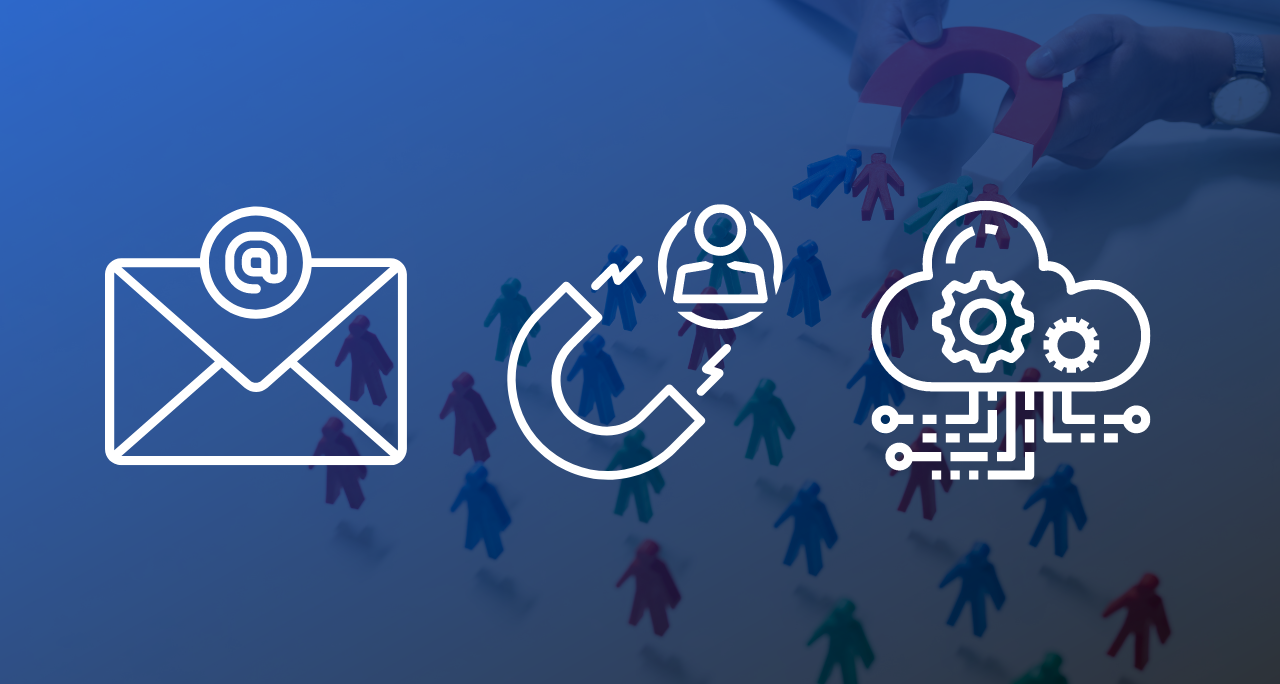When it comes to lead generation, most B2B SaaS brands think along the lines of inbound marketing. It’s definitely a solid way to attract leads but it was never the only way. Cold emailing is a dying art that often closes deals faster, requires very little investment, and is a lot easier to scale.
- Almost 2 billion people use emails worldwide and 97% of marketers plan to use them in their strategies in 2022. Cold emails perform better than other outbound marketing strategies because:
- Cold emails have a very low barrier of entry. Businesses require only the email address while prospects are spared from cold calls that feel invasive.
- Based on your campaign goals, cold emails can be highly scalable with the right automation software.
- Cold email results are predictable, measurable, and repeatable.
But there’s a reason we don’t see enough B2B brands using cold outreach: it’s very easy to miss your mark with cold emails. ESPs have grown stricter in inbox allocation and it’s easier than ever to trigger spam alerts. But you can avoid the challenges by doing cold outreach the right way.
Here are 7 tips B2B SaaS brands can use to successfully leverage cold emails and generate leads:
1. Find your ideal customer profile (ICP)
You’re in the market to sell something that’ll only attract a specific type of buyer. Find that type and you’re already halfway there. Identifying the ideal customer profile (ICP) involves a lot of market research, internal audits, and persistence. Start by answering what is special about your offer, how it will help customers, and who is most likely to buy it. You’ll find the data in your CRM, social media posts, by analyzing B2B podcasts and third-party communities. Now go deeper to find the attributes. It can be location, business size, industry, demographics, and many more.
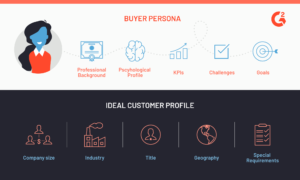
Source: G2
For instance, let’s assume your SaaS helps European eCommerce owners get over cart abandonment issues. Most of your competitors will stick to this information and create their cold outreach campaigns. But to build a strategy that shows results, you have to be very specific. A super-precise ICP could be European eCommerce business owners with 50-100 employees and $100k monthly sales who have posted losses in the last quarter. The more accurate your ICP is, the easier it would be to get a response from your prospects.
2. Build your email list
Cold emails must reach only relevant inboxes. Once you know the type of customers you want to target, you need to find the addresses of the people who make the decisions. A cold email to set up a meeting to discuss your cart abandonment tool will fall flat if it’s sent to the SEO consultant of the company instead of the Product Manager, Co-founder, or Chief Revenue Officer.
GDPR and CCPA compliances introduced a set of rules marketers have to follow in order to be on the legal side when it comes to outbound marketing. That being said, buying email lists is out of the question (and always has been) since you really don’t know where personal information is sourced from and you could potentially face legal consequences.
The safest way to build a targeted email list is by either using inbound marketing techniques or getting publicly available information. Investing resources in building a helpful eBook, informative newsletter or a free tool can help you attract highly relevant prospects to your email lists.
Alternatively, if you are looking to build email lists for cold email campaigns, using email finder tools such as Hunter can help you to stay GDPR and CCPA compliant. Why? Well, Hunter only shows you emails that are publicly available. If you go deeper into GDPR, according to Recital 47 you can legally reach out to prospects who expect your emails. In this case, if emails are publicly available on business websites (for instance on Hunter’s about page you can find everyone’s email address), it shouldn’t come as a surprise to recipients.
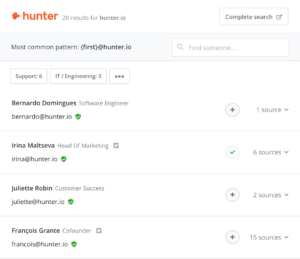
When you know the companies that fit your ICP, you can manually check their website or LinkedIn pages to find relevant email addresses based on LinkedIn information.
3. Segment lists
Now that you have a list of email addresses you want to target, it’s time to segment the lists further. Segmentation is a critical step in cold outreach and it helps you personalize your emails. Not all the addresses you have collected represent the same challenges, goals, or market position. For example, eCommerce stores built on Shopify may have different technological issues in the checkout page than BigCommerce. Even within Europe, you would find companies with different challenges in the UK and the European Union. The trick here is to break your lists into smaller, specific groups based on shared characteristics.
Segmentation is more effective than sending the same email to the entire list and easier than customizing every single email.
4. Clean and trim your contacts
Regardless of how you have built your email list, it’s inevitable that there will be a few inactive or closed email accounts. Just as people change phone numbers without updating everyone who had their old phone number, making it impossible for you to reach them via your virtual phone system, people change addresses without updating them online, and some inboxes might run into temporary issues. You’re more likely to find a lot of inactive addresses if you buy email lists or use the same list for a long time. That’s why it’s important to occasionally trim emails to keep your list healthy, active, and engaged. You can use an email verifying tool to quickly know the status of your email lists and delete the ones that don’t serve your purpose.
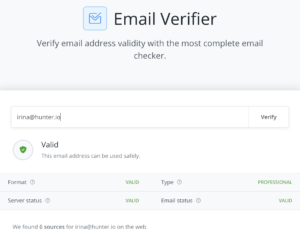
Source: Hunter
Not knowing which addresses are unreachable will impact your deliverability, bounce rate, and spam score. We’ll discuss this in detail later.
5. Draft flawless emails
Now it’s time for the main task: writing an email that is compelling enough to be opened. All high-performing cold emails have two things in common: they’re incredibly relevant to the problem and they’re personalized for the recipient.
Subject line
Cold emails have no time to waste and the subject line sets the tone for the entire email. Don’t write subject lines to play safe, write them to be noticed.
Things you should do to write scroll-stopping subject lines:
- Keep the subject line short, ideally between 4-8 words. Offer value right upfront. There’s no time to waste.
- Hook people in with an honest subject line. Don’t exaggerate or manipulate with clickbaits.
- Experiment with exclamations and emojis and avoid spam words (Hurry up, Click here, Offer, Free, etc.)
- Use the preheader box to expand the subject line and offer a stronger promise
Email body
When a prospect opens an email, they must be encouraged to read till the end of the email. Your first sentence should be strong and lead to the next sentence. Build a logical flow of argument and the prospect will reach the CTA in no time.
Things you should do to write a compelling email body:
- Start the email by touching upon a relevant experience or incident to draw attention. This is where deep research creates all the difference.
- Use short sentences and short paragraphs to keep the body crisp and precise. If faced with writer’s block, try using these AI writers to speed up and create your email content faster.
- Offer free value in each line because the prospect doesn’t know you. They’ll only respond when they understand the value you bring to the table.
Here’s a cold email template that’s short, uses a strong introduction, and concludes with a compelling call to action:
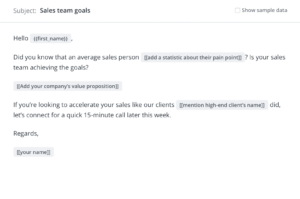
Source: Hunter Templates
Call to action (CTA)
Many cold emails offer multiple tasks to prospects hoping at least one of them will convert. This is a classic mistake. Multiple CTAs confuse prospects and they’ll leave your email without taking the next step. Instead, focus on one thought, one promise, or one potential and make sure the CTA button reflects that. If you’re planning to set up a call, share available dates and times. Make the process as seamless as possible so that the prospect has to take minimum decisions.
6. Use a follow-up campaign
A lot of B2B SaaS marketers give up after sending one cold email. Instead, think of the email as the start of a sequence. Detailed follow-up emails have a better chance of fetching a reply, especially for B2B marketers. According to Woodpecker, long follow-up sequences can lead to a 27% increase in reply rate.
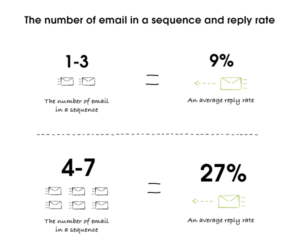
Source: Woodpecker
Start by defining how many follow-up emails you want to include in your campaign and their frequency. It’s good to send 4 to 7 follow-up emails spread across a couple of months to give the prospect time to consider while staying top-of-mind. Remember to connect each new follow-up email with the previous one and offer new value to strengthen your promise. Consider using email account management tools to automate your campaign.
7. Analyze performance data
It’s absolutely crucial to analyze the numbers to fine-tune cold outreach campaigns. For instance, email deliverability is a key factor that decides how many emails actually land in a prospect’s primary folder. Set a pattern of email volume and gradually increase it for your campaign. Also, don’t forget to check IP and domain warming tools and email authentication methods to keep deliverability high. By keeping your email list active, you can drive down bounce rates and spam alerts.
Click-through rate (CTR) is the major conversion metric marketers consider today. Run A/B tests on email copy, subject line, and CTAs to find the combination people most respond to. Avoid using spam triggers and deceptive phrases and if a prospect requests you to remove them from your list, immediately honor that. A high engagement rate ensures that ESPs will not restrict your cold outreach campaigns.
Summary
Generating B2B SaaS leads with cold emailing requires a lot of empathy. Don’t send emails you wouldn’t want to receive. Properly understand your prospects, address specific problems, write authentic emails and stay away from spam tactics. Analyze your performance as you scale and you should have leads replying in no time.
About Author

Irina Maltseva is the Head of Marketing at Hunter. She enjoys working on inbound and product marketing strategies. In her spare time, she entertains her cat Persie and collects airline miles.

